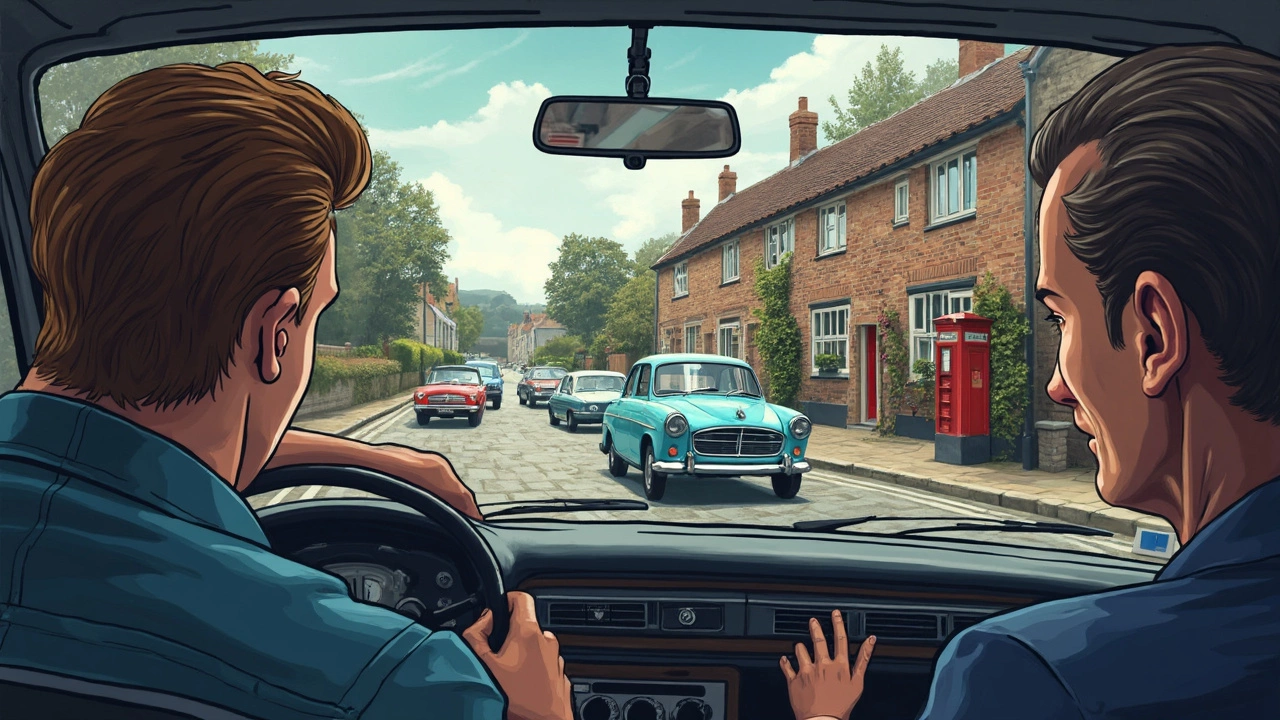Getting ready for a driving test is nerve-wracking, right? But what's really worrying is those sneaky major faults that could totally ruin your day. It's not just about the basics, like knowing which pedal does what. You've got to dig deeper into the dos and especially the don'ts if you want to ace the test.
Imagine this: you've driven straight into a roundabout without signaling. Boom, instant major fault. Sounds silly, but failing to indicate your intentions is one of the top reasons people don't pass. Let's downshift a bit and look at common pitfalls like these that catch folks off guard.
From proper car control to understanding traffic signs, there's a bunch to cover. And let's not forget the mirrors. They aren't there just to check your hair; they're crucial for safety! But don't worry. I've got some tips up my sleeve that can help you tackle the test with confidence.
- Understanding Major Faults
- Control and Technique Errors
- Obeying Traffic Signs
- Proper Use of Mirrors
- Maintaining Safe Distances
- Effective Communication on the Road
Understanding Major Faults
Alright, let's get into the nitty-gritty of what can go wrong during a driving test. Major faults are things that show a lack of skill or safety awareness. They're basically the big no-nos that you want to avoid like the plague if you're hoping to pass your test.
Here’s the thing, if you commit a major fault, it's pretty much game over. The examiner might even stop the test if they think you're not safe. So, understanding what's considered a major fault can save you from making a costly mistake.
Let’s break them down:
- Lack of Control: This means not being confident or safe when handling the car. Think stalling the engine in the middle of an intersection or rolling back on a hill.
- Ignoring Traffic Signs: Missing or misinterpreting stop signs, speed limits, or yield signs. This isn’t just about getting a ticket later; during the test, it's a straight fail.
- Not Using Mirrors Properly: Mirrors are your extra pair of eyes. Failing to check them before changing lanes could result in a major fault because it's a safety risk.
- Failing to Signal: Signaling gives other drivers a heads up. Forgetting to use indicators is like speaking without words; others won't know your next move.
- Unsafe Distances: Too close and you're risking a fender bender, too far and you might get impatient honks. Keeping the right distance is key.
Remember that some stats show about half of all driving test fails are due to major faults. No joke. Being aware of these can really boost your chances of passing on the first try. The more you know about these pitfalls, the better equipped you'll be to avoid them and keep your cool when it matters most.
Control and Technique Errors
Alright, let's talk control and driving technique. These are big deal breakers in a driving test. The stress of the exam can sometimes scramble your brain, making you forget even the basics. But fear not, there's a way forward!
First up, smooth operation. Your driving test examiner is like a hawk when it comes to how you handle the car. Jerky steering, sudden acceleration, or braking can spell trouble. If you can't handle the clutch smoothly or constantly stall the car, that's not looking good either.
- Steering control: Keep your hands at around the 9 and 3 o'clock positions. It's like a happy medium for control.
- Gear shifting: Practice makes perfect here. Shift gears smoothly, and don't stare at the gear stick while doing it—it’s all about feel.
- Clutch control: Finding the bite point takes practice. Do this on a hill or a slope to really get the hang of it.
Another thing to keep in mind is your speed. While over speeding is obviously a no-go, driving too slowly can also be seen as a major fault. Sticking to an appropriate speed for the road conditions is key.
Then, don’t forget about your safe distance from other vehicles. The good old 'two-second rule' is your friend here, doubling it in wet conditions. Tailgating is a big no-no!
If we look at stats, in the UK alone, poor lane discipline accounts for about 16% of failed driving tests. So, stay in your lane, literally. Changing lanes without signals or abrupt lane changes are sure ways to get flunked.
And the one often overlooked? Observation. Keep your head in the game, check those mirrors before any move—especially left and right checks at junctions to spot cyclists or pedestrians.
With these tips in your toolbox, you're set to dodge major faults and improve your driving test chances dramatically. Remember, practice isn't everything—it's the only thing that leads to improvement.
Obeying Traffic Signs
Alright, buckle up because traffic signs aren't just street decorations—they’re the backbone of road safety. Miss one, and it might cost you the test. Ignoring a stop sign can lead to a straight-up fail, regardless of how smooth your parallel parking is. It’s super important to pay attention to these signs as they tell you what you need to do, where you need to stop, and when you should go.
Everyone's seen the classic stop sign, but did you know there's a whole world of signs telling you about speed limits, road conditions, and directions? Keeping an eye out and following these signs is a must. In fact, failing to acknowledge a sign like a no-entry sign or ignoring a school zone speed limit is flagged as a major fault. Yup, these seemingly small mistakes can have a big impact.
Here's a quick checklist for acing this part of your driving test:
- Stop completely at stop signs, even if it feels like a ghost town. The rules still apply.
- Pay close attention to temporary signs, like roadwork or detours. They can pop up when you least expect it.
- Always watch for warning signs, especially ones that caution you about upcoming bends or reduced lanes.
Fun fact: In a recent survey, over 60% of test failures were linked to traffic control errors, so it's vital to nail this part down. Remember, practice makes perfect. Take time to drive around a test area and get familiar with the local signs. Your examiner will appreciate your knowledge and alertness, and you’ll massively increase your chances of passing.

Proper Use of Mirrors
Using mirrors isn't just some box to tick off during your driving test; it's about safety and being aware of your surroundings. Messing this up could easily lead to one of those dreaded major faults that might keep you from getting your license.
Think of mirrors as your best friends on the road. You've got the rear-view and the two side mirrors, each serving a different purpose. The rear-view gives you the big picture of what's happening behind, while the side mirrors help with blind spots.
So, how should you be using them? Here's a quick rundown:
- Before moving off: Always check all mirrors. It might seem obvious, but you'd be surprised how many people forget. This little act keeps you and others safe.
- Changing lanes: Don’t just flick on the indicator and move over. Check the mirrors and your blind spot to make sure no one's sneaking up next to you.
- At roundabouts and junctions: A quick glance in the mirrors gives you a heads-up if another driver is hidden from your main view.
- Every 8-10 seconds: Get into the habit of checking your mirrors every few seconds. It's like your routine health check-up, but for driving!
Not using them correctly in your test? Instant driving test mistakes right there. It’s those small things that add up, and before you know it, you're being told to come back another day.
Here's a little stat to put things in perspective: In 2024, about 10% of driving test fails were due to improper use of mirrors. That's quite a chunk, and a headache you can easily avoid with practice and awareness.
Maintaining Safe Distances
Ever heard of the two-second rule? It’s not just some random advice—it’s golden for driving safety! Keeping a safe distance behind the car in front is essential, not only to pass your driving test but to avoid nasty surprises like sudden stops.
Here's how it works: Pick a fixed point like a sign or a tree. When the car ahead of you passes it, start counting 'one thousand one, one thousand two.' If you reach the mark before finishing the count, you're too close. Slow down and try again.
But what if it’s pouring rain or icy out? Bump that count to four seconds. Bad weather demands extra room since cars take longer to stop. Buffer zones are your best friends here.
Besides weather, there are other scenarios where keeping a good distance is crucial:
- Following large vehicles that block your view. They act like a mobile wall.
- Driving behind motorcycles and scooters. They're nimble but also harder to predict.
- Getting tailgated? Add extra room for any panic stops.
Here's a quick look at stopping distances under different conditions:
| Condition | Distance (meters) |
|---|---|
| Dry Road | 23 |
| Wet Road | 46 |
| Snow/Ice | 183 |
Being mindful of safe distances isn’t just for tests. It's your ticket to reduced stress and better decision-making on the road.
Effective Communication on the Road
Ever wondered why your driving instructor keeps harping on about using signals? Well, it's all about keeping the road drama-free by communicating effectively. Imagine driving in a world where no one signals, and we're all just guessing who's going where. Chaos, right?
First on the list is your indicators. They are your car's way of saying, "Hey, I'm about to turn or change lanes." A blink, and you've just told other drivers whether they need to slow down or change lanes themselves. Trust me, a forgotten signal could count as a major fault on the driving test.
Next up, horn usage. Yeah, you heard me! Your horn isn't just there for singing along to on the highway; it's your go-to for getting a spaced-out driver's attention. But, a quick tip: don't overdo it because that's just rude. Use it only when necessary—like if someone doesn't see the traffic light.
Then there's hand signaling. Sure, it feels a bit like time-traveling to a different era, but they do come in handy. They're not just for cyclists; your examiner might appreciate seeing them if your indicators suddenly won't cooperate.
- Turn signals: Use them every time you change directions or lanes. It's like texting "I'm on my way" before you show up at someone's place.
- Horn: Keep it friendly. A little beep says, "Heads up!" better than a long blast.
- Eye contact: Seriously! Look around, catch other drivers' eyes so they know you've seen them and aren't about to crash their party on the road.
- Hand signals: When all else fails, go old school. A wave does wonders.
According to some studies, clear road communication reduces accidents by almost 40%. That's huge. So, practice these moves, and you're not just prepping for your driving test but also for being a pro on the road.

